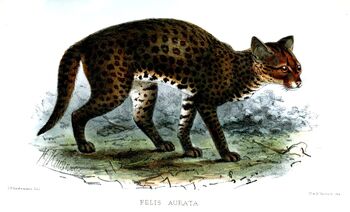| This page uses Creative Commons Licensed content from Wikipedia (view authors). |
| African Golden Cat | |||
|---|---|---|---|

| |||
| General information | |||
| Universe | Real Life | ||
| Classification | Caracal aurata | ||
| Species type | Small Cat | ||
| Homeworld | Earth | ||
| Intelligence | Non-sapient | ||
| Biochemistry | Carbon-based lifeform | ||
| Biological information | |||
| Average length | Body: 24 to 40 in (61 to 101 cm) Tail: 6.3 to 18.1 in (16 to 46 cm) | ||
| Locomotion | Quadrupedal movement | ||
| Feeding behavior | Carnivorous | ||
| Lineage information | |||
| Subspecies | Caracal, Serval | ||
| Cultural information | |||
| Alignment | Neutral | ||
| Sociocultral characteristics | |||
| Scientific taxonomy | |||
| Planet | Earth | ||
| Domain | Eukaryota | ||
| Kingdom | Animalia | ||
| Subkingdom | Eumetazoa | ||
| Infrakingdom | Bilateria | ||
| Superphylum | Deuterostomia | ||
| Phylum | Chordata | ||
| Subphylum | Vertebrata | ||
| Infraphylum | Teleostomi | ||
| Superclass | Tetrapoda | ||
| Class | Mammalia | ||
| Subclass | Theria | ||
| Infraclass | Eutheria | ||
| Superorder | Laurasiatheria | ||
| Order | Carnivora | ||
| Suborder | Feliformia | ||
| Family | Felidae | ||
| Subfamily | Felinae | ||
| Genus | Caracal | ||
| Species | aurata | ||
| Other information | |||
| Status | Vulnerable | ||
The African golden cat (Caracal aurata) is a wild cat distributed in the rainforests of West and Central Africa.
Characteristics[]
The African golden cat is about twice the size of a housecat while resembling the caracal. It is a heavily built cat with stocky, long legs; a relatively short tail; and large paws; with a rounded head considered to be very small in relation to its body size framed by short, untufted ears. In comparison to the caracal they have a longer tail and their ears are shorter. They have brown eyes. Body length usually varies within the range 61 to 101 cm (24 to 40 in). Tail length ranges from 16 to 46 cm (6.3 to 18.1 in), and shoulder height is about 38 to 55 cm (15 to 22 in). The cat weighs around 5.5 to 16 kg (12 to 35 lb), with males being larger than females.
The African golden cat has variable fur color, ranging from chestnut or reddish-brown, greyish brown to dark slaty. Some are spotted, with the spotting ranging from faded tan to heavy black in color. In others the spotting pattern is limited to the belly and inner legs. Its undersides and areas around the eyes, cheeks, chin, and throat are lighter in color to almost white. Its tail is darker on the top and either heavily banded, lightly banded, or plain, ending in a black tip. Cats in the western parts of its range tend to have heavier spotting than those in the eastern areas. Two color morphs, a red and a grey phase, were once thought to indicate separate species, rather than variations of the same species. Despite the wide variation in coat color, pelts of African golden cats can be identified by the presence of a distinctive whorled ridge of fur in front of the shoulders, where the hairs change direction.
Distribution and habitat[]
The African golden cat inhabits tropical forests from sea level to 3,000 m (9,800 ft). It prefers dense, moist forest with heavy undergrowth, and is often found close to rivers, but it may also be found in cloud forest, bamboo forests, and high moorland habitats. The cat is found from Senegal in the west to Kenya in the east, and ranges as far north as the Central African Republic and as far south as northern Angola.
Ecology and behavior[]
Due to its extremely reclusive habits, little is known about the behavior of African golden cats. They are solitary animals, and are normally crepuscular or nocturnal, although they have also been observed hunting during the day, depending on the availability of local prey.
African golden cats are able to climb, but hunt primarily on the ground. They mainly feed on tree hyrax, rodents, but also hunt birds, small monkeys, duikers, young of giant forest hog, and small antelope. They have also been known to take domestic poultry and livestock.
Reproduction[]
Knowledge of the African golden cat's reproductive habits is based on captive specimens. They breed readily in captivity.[citation needed] The mother gives birth to one or two kittens after a gestation period of around 75 days. The kittens weigh 180 to 235 g (6.3 to 8.3 oz), but grow and develop rapidly in comparison with other small cat species. One individual was reported to be scaling a 40-cm wall within 16 days of birth, reflecting a high degree of physical agility from an early age. The kittens' eyes open within a week of birth, and they are weaned at 6–8 weeks. Females reach sexual maturity at 11 months of age, but the males do not do so until 18 months.
These cats live up to 12 years in captivity, but their lifespan in the wild is unknown.